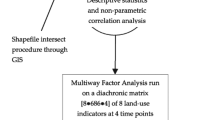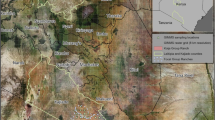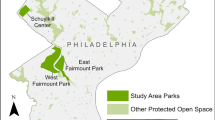Abstract
This study explores the connections between vegetation cover change, environmental stewardship, and building footprint change in New York City neighborhoods from the years 2000 to 2010. We use a mixed-methods multidisciplinary approach to analyze spatially explicit social and ecological data. Most neighborhoods lost vegetation during the study period. Neighborhoods that gained vegetation tended to have, on average, more stewardship groups. We contextualize the ways in which stewardship groups lead to the observed decadal- and neighborhood-scale changes in urban vegetation cover. This multidisciplinary synthesis combines the strengths of quantitative data to identify patterns, and qualitative data to understand process. While we recognize the complexity of cities and the potential confounding factors, this exploratory analysis uses sound theory and data from a mixed methodological approach to show the role of urban environmental stewardship in affecting the New York City landscape.





Similar content being viewed by others
References
Adams JB, Smith MO, Johnson PE (1986) Spectral mixture modeling: a new analysis of rock and soil types at the Viking lander 1 site. J Geophys Res 91:8089–8122
Anderson J, Hardy, E, Roach, J, Witmer, R (1976) Land use and land cover classification systems for use with remote sensor data. USGS prof paper 964
Beattie J, Kollin C, Moll G (2000) Trees tackle clean water regs. Am For 106:18–19
Beckett K, Freer-Smith P, Taylor G (2000) Effective tree species for local air quality management. J Arboric Urban For 26:12–19
Brooklyn Bridge Park, 2012. Brooklyn Bridge Park. Retrieved Nov 19th, 2012 from http://www.brooklynbridgepark.org/the-park
Cadenasso M, Pickett STA, Schwarz K (2007) Spatial heterogeneity in urban ecosystems: reconceptualizing land cover and a framework for classification. Front Ecol and the Environ 5:80–88
Campbell LK (2014) Constructing New York City’s urban forest: the politics and governance of the Million Trees NYC campaign. In Sandberg LA, Bardekjian A, Butt S, (eds) Urban Forests, Trees, and Green Space: A Political Ecology Perspective. Earthscan/Routledge.
Connolly JJ, Svendsen ES, Fisher DR, Campbell LK (2013) Organizing urban ecosystem services through environmental stewardship governance in New York City. Landsc Urban Plan 109:76–84
Dwyer J, McPherson E, Schroeder H, Rowntree R (1992) Assessing the benefits and costs of the urban forest. Arboric Urban For 18:227–234
ESRI, 2009, ArcMap 9.3.1 Redlands, California: ESRI.
Fernandez-Juricic E (2000) Avifaunal use of wooded streets in an urban landscape. Conserv Biol 14:513–521
Fisher D, Campbell LK, Svendsen ES (2012) The organizational structure of urban environmental stewardship. Env Polit 21:26–48
Grove JM, Burch WR, Pickett STA (2005) Social mosaics and urban community forestry in Baltimore, Maryland introduction: rationale for urban community forestry continuities from rural to urban community forestry. In: Lee RG, Field DR (eds) Communities and forests: where people meet the land. Oregon State University Press, Corvalis, pp 248–273
Grove JM, Pickett STA, Whitmer AC, and Cadenasso ML (2013) Building an Urban LTSER: the case of the Baltimore Ecosystem Study and the D.C./B.C. ULTRA-Ex Project. In Singh SJ, Haberl H, Chertow M, Mirtl M, Schmid M (Eds.) Dordrecht: Springer Netherlands. doi:10.1007/978-94-007-1177-8
Hager MA, WilsonS PTH, Rooney PM (2003) Response rates for mail surveys of nonprofit organizations: a review and empirical test. Nonprofit Volunt Sect Q 32(2):252–267
Hartig T, Mang M, Evans G (1991) Restorative effects of natural environment. Env Behavior 23:3–26
Hudson River Park Trust (2012) Planning and construction. Retrieved November 19th, 2012 from http://www.hudsonriverpark.org/vision-and-progress/planning-and-construction
IBM (2009) PASW statistics 18.0.0. IBM (SPSS), Chicago
Kovacs KF, Haight RG, Jung S, Locke DH, O’Neil-Dunne J (2013) The marginal cost of carbon abatement from planting street trees in New York City. Ecological Econ 95:1–10. doi:10.1016/j.ecolecon.2013.08.012
Kuo F, Sullivan W (2001) Aggression and violence in the inner city: effects of environment via mental fatigue. Env Behavior 33:543–571
MacFaden SW, O’Neil-Dunne JPM, Royar AR, Lu JWT, Rundle AG (2012) High-resolution tree canopy mapping for New York City using LiDAR and object-based image analysis. Appl Rem Sens 6:1–23
McPherson G, Nowak DJ, Rowntree R (1994) Chicago’s urban forest ecosystem: results of the Chicago urban forest climate project. General Technical Report NE-186. USDA Forest Service Northeastern Forest Experimental Research Station, Radnor, Pennsylvania
Nowak DJ (2002) The effects of urban trees on air quality. Retrieved January 26th, 2011 from http://nrs.fs.fed.us/units/urban/local-resources/downloads/Tree_Air_Qual.pdf
Nowak DJ, Crane D (2002) Carbon storage and sequestration by urban trees in the USA. Environ Pollut 116:381–389
Nowak DJ, Greenfield EJ (2012) Tree and impervious cover change in U.S. cities. Urban For Urban Green 11(1):21–30. doi:10.1016/j.ufug.2011.11.005
Nowak DJ, McHale P, Ibarra M, Crane D, Stevens J, Luley C (1998) Modeling the effects of urban vegetation on air pollution. In: Gryning S, Chaumerliac N (eds) Air pollution modeling and its application XII. Plenum Press, New York, pp 399–407
Nowak DJ, Hoehn R, Crane D, Stevens J, Walton J (2007) Assessing urban forest effects and values: New York City’s urban forest. Retrieved January 26th, 2011 from http://www.nrs.fs.fed.us/pubs/rb/rb_nrs009.pdf
O’Neil-Dunne JPM (2012) A Report on the City of New York’s existing and possible tree canopy. http://www.fs.fed.us/nrs/utc/reports/UTC_NYC_Report_2010.pdf Accessed July 15, 2013
Openshaw S (1984) The modifiable areal unit problem. Concepts and Tech in Mod Geogr 38:1–41
Romolini M, Grove JM, Locke DH (2013) Assessing and comparing relationships between urban environmental stewardship networks and land cover in Baltimore and Seattle. Landsc Urban Plan 120:190–207. doi:10.1016/j.landurbplan.2013.08.008
Rosenfeld A, Akbari H, Romm J, Pomerantz M (1998) Cool communities: strategies for heat island mitigation and smog reduction. Energ Build 28:51–62
Rudd H, Vala J, Schaefer V (2002) Importance of backyard habitat in a comprehensive biodiversity conservation strategy: a connectivity analysis of urban green spaces. Restor Ecol 10:368–375
Scott J (2000) Social network analysis: a handbook (2nd ed.). Sage Publications, London
Small C (2001) Estimation of urban vegetation abundance by spectral mixture analysis. Intl J Remote Sens 21:1305–1334
Small C (2004) The Landsat ETM + spectral mixing space. Remote Sens Environ 93:1–17
Small C, Lu JTW (2006) Estimation and vicarious validation of urban vegetation abundance by spectral mixture analysis. Remote Sens Environ 100:441–456
Svendsen ES, Campbell LK (2008) Urban ecological stewardship: understanding the structure, function and management. Cities and the Environ 1:1–31
The City of New York, Mayor Michael R. Bloomberg (2007) PlaNYC: a greener, greater New York. Retrived November 19th, 2012 from http://www.nyc.gov/html/planyc2030/html/theplan/the-plan.shtml
Tooke T, Coops N, Goodwin N, Voogt J (2009) Extracting urban vegetation characteristics using spectral mixture analysis and decision tree classifications. Remote Sens Environ 113:398–407
Van de Voorde T, Vlaeminck J, Canters F (2008) Comparing different approaches for mapping urban vegetation cover from Landsat ETM + data: a case study on Brussels. Sensors 8:3880–3902
Acknowledgments
The authors acknowledge support from the National Science Foundation Urban Long Term Research Area Exploratory (ULTRA-Ex) grant DEB-0948451, the US Forest Service Northern Research Station, the Libby Fund Enhancement Award from Clark University, and the Carpenter-Sperry Award. We also thank Walter Rosenbaum, Jessie Braden (Pratt Institute for Community Development), James Connolly (Northeastern University), and our anonymous reviewers for helpful input.
Author information
Authors and Affiliations
Corresponding author
Rights and permissions
About this article
Cite this article
Locke, D.H., King, K.L., Svendsen, E.S. et al. Urban environmental stewardship and changes in vegetative cover and building footprint in New York City neighborhoods (2000–2010). J Environ Stud Sci 4, 250–262 (2014). https://doi.org/10.1007/s13412-014-0176-x
Published:
Issue Date:
DOI: https://doi.org/10.1007/s13412-014-0176-x




